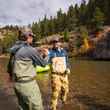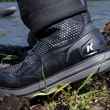There’s a small lake at the end of a gravel road in Northern Ontario. It’s much like a thousand other Canadian lakes, ringed with cottages, perfectly shorn birch and maple that the deer can reach from the ice to help get through a long winter, and a multitude of docks—from concrete and steel to rusty nails and pallets.
One of the old wooden docks is easily accessible from my river cottage. It’s owned by a friend and a short 15-minute stroll along the road, where I can only imagine that from behind, I look like Andy Taylor ambling to his favorite Mayberry fishing hole, pole in hand and whistling. If it’s the right time of year, I can come across a snapping turtle laying her eggs in the soft gravel on the shoulder of the road. When I do, I mark the spot with a branch and come by later to put a screen over it to protect the eggs from the raccoons, foxes, coyotes, and skunks. I like those predators, but I think baby turtles need a break. No turtles today.
The rod in my hand is a Redington Classic Trout. It’s 7’ 6” in length and a two-weight in size. I’ve fitted it with a beat-up Scientific Anglers System 2 and a Cortland Double Taper Peach floating line. The leader is about 7’ of whatever I left on it from the last outing. I may change this leader every few years. Or not. There’s a dry fly tied on, but it doesn’t matter which. It rarely does when fishing for panfish.
I have caught a 28” brown trout on a Woolly Bugger in Patagonia, a 23” in brown in Connecticut on a mouse and a 21” rainbow in Wyoming on a size 22 LBS. I have caught fish all over the world. But my best fishing days have been standing on this falling down dock casting into the edges of the rushes for whatever likes the look of my fly. I am there to simplify. To go back to an easier time when the only thing that mattered was fishing.
My only concession to extra gear is an additional fly tucked into the brim of my hat just in case a bad knot on the first slips or a fish breaks me on a tangle of logs in the reeds. If I lose both, I go home.
The dock requires a quick tightrope walk across a lengthwise board that bridges a very large gap in the gangplank where the old rotting boards have yet to be replaced. I doubt they ever will be. It bounces as you cross but it’s easy to navigate once you’ve fallen off. And everyone has fallen off. I did while holding a lit Perla del Mar Corojo and a glass of Laphroaig. I lost the whisky but somehow kept the cigar lit. Priorities.
Lined with used tires so old they are bleached grey, the structure runs a good 30’ into the lake, just enough for a decent back cast that won’t get hung on the shore willows and allow you to put your fly in the open water. The perch are out there, occasional pickerel too. Cruising pike if you want to throw streamers but that’s beyond the ability of the two-weight and not the experience I’m after. The cove is protected by a small curve of cliff to the right and will calm before any other part of the lake. When the setting sun hits it just right, my fly will land on the quiet surface and send out golden circles. It’s a shame it attracts fish as it really is a Kandinsky on the water. I never twitch my fly until the last circle dissipates, just for the beauty of it all.
My interest is the reeds to the left. Every panfish I can name and a few I can’t cruise those plants. Put a fly anywhere and there’s a mad boiling rush to see who eats first. It really doesn’t matter, as with a little time I will catch every fish. A few multiple times. I can hook, reel in and release a panfish in under 10 seconds. Twenty casts means twenty fish. I’ve never tried, but I’m sure I could hit four digits if I had the inclination and my arm held. But that sounds like a competition and I’m a firm believer that competition has no business near a fly rod.
Which brings us to the bass. I will admit to a certain confusion with regards to bass fishing. I can’t get my head around the fact that you can catch a world record off the end of the dock, turn professional and buy a $100,000 boat, then park it 20 feet offshore and cast back toward the dock. Not to mention the garish sponsor-clad fishing shirted men-children pumping their fists and screaming to the heavens (and cameras) that they caught a fish that was put here to provide easy angling opportunity for kids and addled old men. I have embarrassed myself enough in nature. I don’t need to fist pump.
My third cast lands beside the larger of the sunken logs and the water implodes underneath as if someone dropped a boulder from the sky. The 2wt bends in a way that I doubt the designers intended but it holds as the line rips off the reel. I palm the spool and the bass—it has to be a bass—flies through the reeds. I let him have his head. Within reason, of course, as there’s no backing on the reel. I steer him to the open water and manage to turn him when there is only about ten feet left on the spool. He zigzags across the water as I bring him close. Big largemouth. Not sure how big, but fat and healthy, and heavy enough that I slide my other hand underneath his body for support. Probably would have won me a few thousand in a local tournament. A quick look then back into the lake. He may have spooked the area and the bite dies down pretty quickly.
The sun is close to dropping behind the tree-line as a dragonfly lands on one of the dock posts, its wings quivering slightly in what remains of the heat. It and the dock take on a warm hue in the deep afternoon light and I race the sun to see who can touch the water at the last moment. We tie and I let the fly lay as the golden circles gently spread until the light disappears and they melt back into the lake.
The fish know better than to disturb the moment and I reel in slowly and walk home, looking for turtles. Whistling.






























Comments
Richard replied on Permalink
Great writing!
“ The leader is about 7’ of whatever I left on it from the last outing.” This is one of fishing’s great recurring mysteries.
Pages